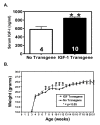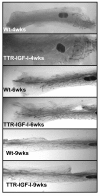A moderate elevation of circulating levels of IGF-I does not alter ErbB2 induced mammary tumorigenesis
- PMID: 21867536
- PMCID: PMC3189189
- DOI: 10.1186/1471-2407-11-377
A moderate elevation of circulating levels of IGF-I does not alter ErbB2 induced mammary tumorigenesis
Abstract
Background: Epidemiological evidence suggests that moderately elevated levels of circulating insulin-like growth factor-I (IGF-I) are associated with increased risk of breast cancer in women. How circulating IGF-I may promote breast cancer incidence is unknown, however, increased IGF-I signaling is linked to trastuzumab resistance in ErbB2 positive breast cancer. Few models have directly examined the effect of moderately high levels of circulating IGF-I on breast cancer initiation and progression. The purpose of this study was to assess the ability of circulating IGF-I to independently initiate mammary tumorigenesis and/or accelerate the progression of ErbB2 mediated mammary tumor growth.
Methods: We crossed heterozygous TTR-IGF-I mice with heterozygous MMTV-ErbB2 mice to generate 4 different genotypes: TTR-IGF-I/MMTV-ErbB2 (bigenic), TTR-IGF-I only, MMTV-ErbB2 only, and wild type (wt). Virgin females were palpated twice a week and harvested when tumors reached 1000 mm(3). For study of normal development, blood and tissue were harvested at 4, 6 and 9 weeks of age in TTR-IGF-I and wt mice.
Results: TTR-IGF-I and TTR-IGF-I/ErbB2 bigenic mice showed a moderate 35% increase in circulating total IGF-I compared to ErbB2 and wt control mice. Elevation of circulating IGF-I had no effect upon pubertal mammary gland development. The transgenic increase in IGF-I alone wasn't sufficient to initiate mammary tumorigenesis. Elevated circulating IGF-I had no effect upon ErbB2-induced mammary tumorigenesis or metastasis, with median time to tumor formation being 30 wks and 33 wks in TTR-IGF-I/ErbB2 bigenic and ErbB2 mice respectively (p = 0.65). Levels of IGF-I in lysates from ErbB2/TTR-IGF-I tumors compared to ErbB2 was elevated in a similar manner to the circulating IGF-I, however, there was no effect on the rate of tumor growth (p = 0.23). There were no morphological differences in tumor type (solid adenocarcinomas) between bigenic and ErbB2 mammary glands.
Conclusion: Using the first transgenic animal model to elevate circulating levels of IGF-I to those comparable to women at increased risk of breast cancer, we showed that moderately high levels of systemic IGF-I have no effect on pubertal mammary gland development, initiating mammary tumorigenesis or promoting ErbB2 driven mammary carcinogenesis. Our work suggests that ErbB2-induced mammary tumorigenesis is independent of the normal variation in circulating levels of IGF-I.
Figures





Similar articles
-
Sustained trophism of the mammary gland is sufficient to accelerate and synchronize development of ErbB2/Neu-induced tumors.Oncogene. 2006 Jun 1;25(23):3325-34. doi: 10.1038/sj.onc.1209365. Epub 2006 Jan 23. Oncogene. 2006. PMID: 16434967 Free PMC article.
-
Reduced androgen receptor expression accelerates the onset of ERBB2 induced breast tumors in female mice.PLoS One. 2013 Apr 8;8(4):e60455. doi: 10.1371/journal.pone.0060455. Print 2013. PLoS One. 2013. PMID: 23593223 Free PMC article.
-
Protein tyrosine kinase 6 promotes ERBB2-induced mammary gland tumorigenesis in the mouse.Cell Death Dis. 2015 Aug 6;6(8):e1848. doi: 10.1038/cddis.2015.210. Cell Death Dis. 2015. PMID: 26247733 Free PMC article.
-
Developmental timing of activated erbB2 expression plays a critical role in the induction of mammary tumors.Cell Cycle. 2004 Sep;3(9):1111-3. Epub 2004 Sep 1. Cell Cycle. 2004. PMID: 15326381 Review.
-
ErbB2 activation and signal transduction in normal and malignant mammary cells.J Mammary Gland Biol Neoplasia. 1996 Apr;1(2):199-206. doi: 10.1007/BF02013643. J Mammary Gland Biol Neoplasia. 1996. PMID: 10887493 Review.
Cited by
-
Mice with gene alterations in the GH and IGF family.Pituitary. 2022 Feb;25(1):1-51. doi: 10.1007/s11102-021-01191-y. Epub 2021 Nov 19. Pituitary. 2022. PMID: 34797529 Free PMC article. Review.
-
Elevated GH/IGF-I promotes mammary tumors in high-fat, but not low-fat, fed mice.Carcinogenesis. 2014 Nov;35(11):2467-73. doi: 10.1093/carcin/bgu161. Epub 2014 Aug 1. Carcinogenesis. 2014. PMID: 25085903 Free PMC article.
-
The role of the insulin-like growth factor-1 system in breast cancer.Mol Cancer. 2015 Feb 15;14:43. doi: 10.1186/s12943-015-0291-7. Mol Cancer. 2015. PMID: 25743390 Free PMC article. Review.
-
Higher IGFBP-1 to IGF-1 serum ratio predicts unfavourable survival in patients with nasopharyngeal carcinoma.BMC Cancer. 2017 Jan 31;17(1):90. doi: 10.1186/s12885-017-3068-0. BMC Cancer. 2017. PMID: 28143425 Free PMC article.
-
IGF binding proteins in cancer: mechanistic and clinical insights.Nat Rev Cancer. 2014 May;14(5):329-41. doi: 10.1038/nrc3720. Epub 2014 Apr 10. Nat Rev Cancer. 2014. PMID: 24722429 Review.
References
-
- Boyd NF, Lockwood GA, Byng JW, Tritchler DL, Yaffe MJ. Mammographic densities and breast cancer risk. Cancer Epidemiol Biomarkers Prev. 1998;7:1133–1144. - PubMed
-
- Byrne C, Hankinson SE, Pollak M, Willett WC, Colditz GA, Speizer FE. Insulin-like growth factors and mammographic density. Growth Horm IGF Res. 2000;10(Suppl A):S24–25. - PubMed
Publication types
MeSH terms
Substances
Grants and funding
LinkOut - more resources
Full Text Sources
Research Materials
Miscellaneous

